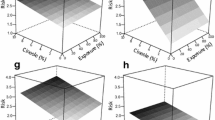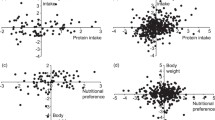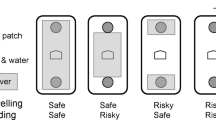Summary
Juncos' preferences for constant versus variable food rewards were tested in three series of aviary experiments. Deprivation and feeding rates were varied across the three treatments, but the mean of the variable reward equalled the constant reward in every experiment. When the birds gained energy faster than required to meet all 24-h costs, they preferred the constant reward. When the birds' energy intake was less than the minimally required rate, they preferred the variable reward. When energy intake just balanced average daily costs, the birds preferred the constant reward or were indifferent, and their response depended on the particular mean-variance combination presented.
Similar content being viewed by others
References
Beddington J, May RM (1977) Harvesting natural populations in a randomly fluctuating environment. Science 197:463–465
Caraco T (1980) On foraging time allocation in a stochastic environment. Ecology 61:119–128
Caraco T, Martindale S, Whittam TS (1980) An empirical demonstration of risk-sensitive foraging preferences. Anim Behav 28:820–830
Coombs CH (1969) Portfolio theory: a theory of risky decision making. In: La decision. Centre National de la Recherche, Scientifique, Paris
Coombs CH, Huang LC (1976) Tests of betweeness property of expected utility. J Math Psychol 13:323–337
Friedman M, Savage LJ (1962) The utility analysis of choices involving risk. In: Hamilton EJ, Rees A, Johnson AG (eds) Landmarks in political economy. University of Chicago Press, Chicago, pp 297–336
Gill FB, Wolf LL (1975) Economics of feeding territoriality in the Golden-winged Sunbird. Ecology 56:333–345
Gillespie JH (1977) Natural selection for variances in offspring numbers: a new evolutionary principle. Am Nat 111:1010–1014
Gleit A (1978) Optimal harvesting in continuous time with stochastic growth. Math Biosci 41:111–123
Green RF (in press) Bayesian birds: a simple example of Oaten's stochastic model of optimal foraging. Theor Popul Biol
Herrnstein RJ (1964) Aperiodicity as a factor in choice. J Exp Anal Behav 7:179–182
Istock CA (1978) Fitness variation in a natural population. In: Dingle H (ed) Evolution of migration and diapause. Springer, Berlin Heidelberg New York, pp 171–190
Krebs JR, Kacelnik A, Taylor P (1978) Test of optimal sampling by foraging great tits. Nature 275:27–31
Lea SEG (1979) Foraging and reinforcement schedules in the pigeon: optimal and non-optimal aspects of choice. Anim Behav 27:875–886
MacArthur RA, Pianka ER (1966) On optimal use of a patchy environment. Am Nat 100:603–609
Oaten A (1979) Optimal foraging in patches: a case for stochasticity. Theor Popul Biol 12:263–285
Oster GF, Wilson EO (1978) Caste and ecology in the social insects. Mon Popul Biol 12:1–352
Pimm SL (1978) An experimental approach to the effects of predictability on community structure. Am Zool 18:797–808
Poole RW (1974) An introduction to quantitative ecology. McGraw-Hill, New York
Pubols BH (1962) Constant vs. variable delay of reinforcement. J Comp Physiol Psychol 55:52–56
Pulliam HR (1974) On the theory of optimal diets. Am Nat 108:59–74
Pulliam HR, Millikan GC (in press) Social organization in the non-reprodutive season. In: Farner DS, King JR (eds) Avian biology, vol VI. Academic Press, New York
Pyke GH, Pulliam HR, Charnov EL (1977) Optimal foraging: a selective review of theory and tests. Q Rev Biol 52:137–154
Real LA (1980a) Fitness, uncertainty, and the role of diversification in evolution and behavior. Am Nat 115:623–638
Real LA (1980b) On uncertainty and the law of diminishing returns in evolution and behavior. In: Staddon JER (ed) Limits to action: The allocation of individual behavior. Academic Press, New York, pp 37–64
Real LA Iin press) Uncertainty and pollinator-plant interactions: the foraging behavior of bees and wasps on artificial flowers. Ecology
Schaffer WM (1974) Optimal reproductive effort in fluctuating environments. Am Nat 108:783–790
Shettleworth SJ (1978) Reinforcement and the organization of behavior in golden hamsters: punishment of three action patterns. Learn Motiv 9:99–123
Sokal RR, Rohlf FJ (1969) Biometry. Freeman, San Francisco
Southwood TRE (1977) Habitat, the templat for ecological strategies? J Anim Ecol 46:337–365
Stephens DW (in press) The logic of risk-sensitive foraging preferences. Anim Behav
Taylor RJ (1976) Value of clumping to prey and the evolutionary response of ambush predators. Am Nat 110:13–29
Templeton AR, Rothman ED (1974) Evolution in heterogeneous environments. Am Nat 108:409–428
Thompson WA, Vertinsky I, Krebs JR (1974) The survival value of flocking in birds: a simulation model. J Anim Ecol 43:785–820
Tversky A (1967) Utility theory and additivity analysis of risky choices. J Exp Psychol 75:27–36
Author information
Authors and Affiliations
Rights and permissions
About this article
Cite this article
Caraco, T. Energy budgets, risk and foraging preferences in dark-eyed juncos (Junco hyemalis). Behav Ecol Sociobiol 8, 213–217 (1981). https://doi.org/10.1007/BF00299833
Received:
Accepted:
Issue Date:
DOI: https://doi.org/10.1007/BF00299833




